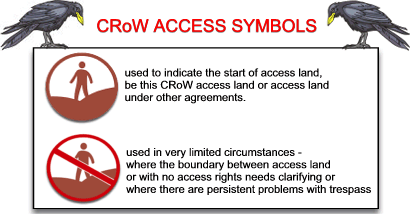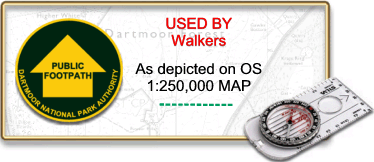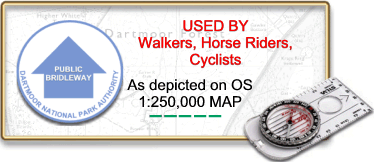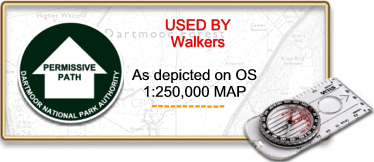
‘Goosey, Goosey, Gander, where can I wander?’
Around about this time of year this website gets several queries from people who will be visiting Dartmoor for thr first time and want to know exactly where they can or can’t walk. For example:
“Hi, I wonder if you can help, we will be visiting Dartmoor shortly and are unsure as to where it is permissible to walk and which is the best map to use. Also are there any particular areas to avoid?”
The simple answer to that question is anywhere on the Dartmoor commons and access land both of which cover a vast area of the moor. As far as avoiding areas the main concern is the military ranges and firing times should always be checked before your visit to avoid disappointment.
There was a great deal of excitement when the Countryside Rights of Way (CRoW) act was passed in November 2000 as many thought it was in effect the right to roam wherever one fancied. This certainly was not and is not the case because it only applies to land that has been defined ‘Open Country’ which refers to mountains, moors, heaths, downlands and registered commons all of which are now called ‘access lands’. There has always been a good degree of freedom on Dartmoor as far as where you can go and what you can do but having now looked at the implications of the CRoW act have things changed?
What exactly is access land? Basically it defines an area of land where anyone is free to roam without having the constraints of having to stick to defined footpaths, bridleways etc. It is important to note that it does not encompass woods and river banks unless they are on access land or the landowner has dedicated permanent access through such areas. The kind folk at the Ordnance Survey have made it very easy to identify the various types of access land, open access is now of a yellow hue and woodlands are a lime green.

The Three Types of Access Land as Depicted on the OL28 OS Map.
As briefly noted above, there is one other type of access land that can be found of Dartmoor and that is the land used by the military for training purposes, comprised of three ranges shown on the OS map as being defined by a series of small, red triangles. Here access is allowed on any day when training is not taking place. It is always best when planning to enter any of the three ranges to check the firing times first because there is nothing worse than getting there and finding access is denied. The Dartmoor Training Area has a list of dates when it is intended to close the ranges – see link opposite.
It is also interesting to note that the Dartmoor Commons do not come under the auspices of the CRoW Act as the right of access was already in place prior to 2000. In the case of commons the access rights come under the Dartmoor Commons Act of 1985 not the rights of the CRoW Act.
There are several restrictions as to what can be done on access land, for instance it is permissible to take a dog into such areas providing it is kept on a fixed leash (2m or less) between the 1st of March and the 31st of July (bird breeding and lambing season). The dog must be kept on such a lead whilst near livestock and there may be further restricted access to land which is used for lambing or high wildlife value. In the majority of cases a dog is the only animal allowed on access land apart from horses if they adhere to bridleway or byways. There is a slight grey area here as it is possible to ride a horse on access land if there traditionally has been such rights afforded by the landowner. This restriction does not apply on Dartmoor Commons where horse riders have open access rights.
As far as vehicles go it is not permissible to ride a bicycle on access land unless it is on a bridleway, byway or designated cycle route. It is forbidden to ride a motorcycle or drive a vehicle on access land unless it is on a byway, there is however a concession for prams and wheelchairs.
There is a defined list of activities one can do whilst on access land, it’s ok to walk, run, watch birds, and climb rocks (provided there are no local restrictions in place). Officially you cannot;
|
Camp. |
|
|
Ride horses. |
|
|
Drive/Ride a vehicle other than an invalid carriage. |
|
|
Use a vessel or sailboard on non-tidal water. |
|
|
Take any animal other than a dog. |
|
|
Commit a criminal offence. |
|
|
Cycle, |
|
|
Light a fire. |
|
|
Feed livestock. |
|
|
Bathe in non-tidal water. |
|
|
Use a metal detector, |
|
|
Hunt, shoot, fish, trap, snare any animal or bird. |
|
|
Intentionally remove, damage or destroy any plant, shrub, tree or root. |
|
|
Take, damage or destroy bird eggs and nests. |
|
|
Obstruct the flow of watercourses or drains. |
|
|
Interfere with fences or barriers. |
|
|
Take part in organised games. |
|
|
Take part in commercial activities. |
|
|
Hang Gliding or Paragliding |
|
In many cases the point of entry onto access land is defined and which has been chosen to avoid damage to walls, hedges or other boundaries. In most cases these entry points are marked as are areas of no access:

The first response to this question is that it is vital to get a map that shows access land, footpaths, bridleways etc., all of which appear on the Ordnance Survey Explorer Map number OL28.

There are a variety of signs which mark the various footpaths, bridleways and byways and denotes exactly which type of access is allowed and by whom as cam be seen below.
 |
 |
 |
 |
So as you can see, compared with some of the UK’s National Parks there is a large amount of freedom to explore and enjoy Dartmoor. However it is vital to remember that it is a living and working landscape and at very least its important to obey the Countryside Code. Should you have any concerns about venturing into the moor the other option is always to join a guided walk or even hire a personal guide, all these services are expertly provided by Moorland Guides
Recently there have been many cases of people leaving litter, their dogs harassing livestock, mindless vandalism and graffiti spraying. If you are one of the few likely to be participating in any of the above don’t bother visiting the moor as you are not welcome.
 Legendary Dartmoor The many aspects past and present of Dartmoor
Legendary Dartmoor The many aspects past and present of Dartmoor

Hi Tim, just looking at your activity chart in research for an article. Under Common land it says you cannot ride a horse however the 1985 Commons Act did legalise both foot and horse use.
Thanks Rob
Thanks Rob, duly amended.
Tim, I note Rob Stevenson’s comment above, and your reply to it. So far as I can see your chart of permitted activities on the various types of access land remains inaccurate so far as horse-riding and Dartmoor goes. The information in this link seems at conflict with your own if I understand all this correctly.